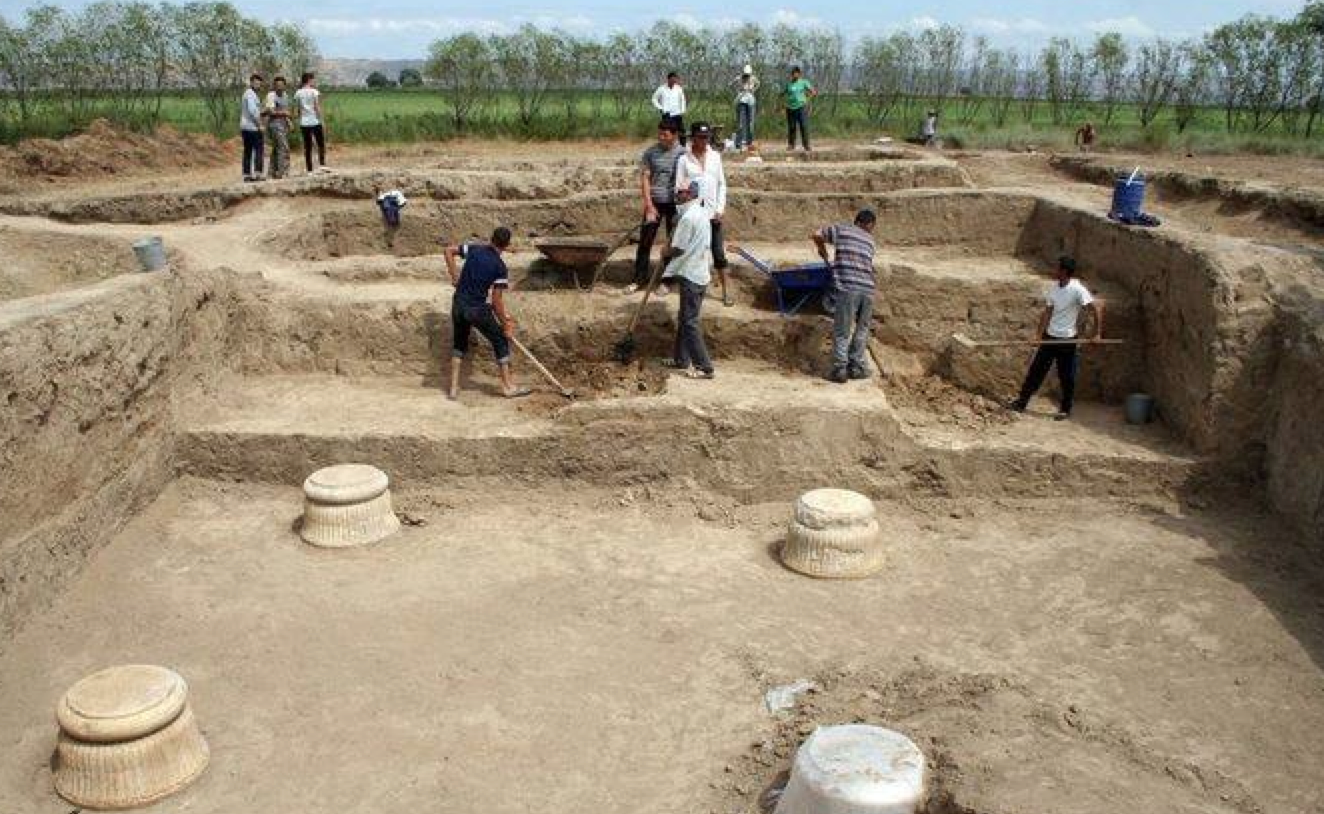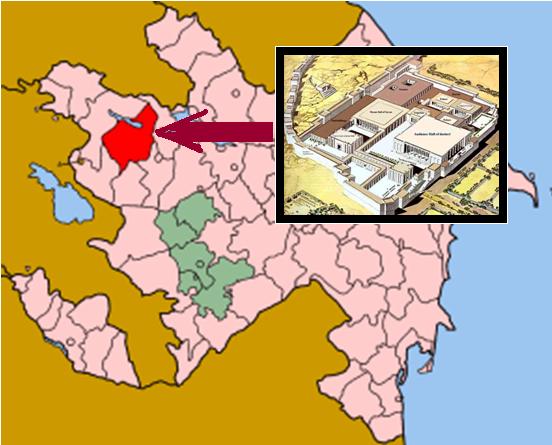The article below on the palaces of the Achaemenid Empire discovered in Arran (modern Republic of Azerbaijan since 1918) was posted in the Awti website.
================================================================
The discovery of the great palace of the Achaemenid Empire – the largest outside of Iran, was announced by the Academy of Sciences of Azerbaijan with reference to the Russian magazine “Science and Life.”
In the large hall, opposite the entrance to the palace, is the place throne – it was first discovered in 2006 by the rising in the central part of the building (the first Achaemenid throne was found in in Pasargadae in the 1960s, by the British team of archaeologists led by D. Stronach). From the main entrance to the palace in the village “Garadzhamerli”, porticoes and columns (propylene) were found extending to the north and south exterior wall. During the excavations of the palace ceramic vessels, glass bowls and some ceramic sink for water (drainage) were found with portions of pluming. Two inscriptions probably written in Aramaic one of the Empire’s languages for communication at the time were also found. Archaeologists are now waiting for the finds of written sources – the cuneiform inscriptions on the pillars. Perhaps the signs are in three languages: Old Persian, Akkadian, Elamite. It is also possible that there may be archives of clay tablets.
 Excavation of the Achaemenid building at Qarajamirli. The researchers Babaev, Gagoshidze, Knauß and Florian in 2007 (An Achaemenid “Palace” at Qarajamirli (Azerbaijan) Preliminary Report on the Excavations in 2006. Ancient Civilizations from Scythia to Siberia, Volume 13, Numbers 1-2,, pp. 31-45(15)) discovered the remains of a monumental building as well as fragments of limestone column bases. This follows closely the plan of an Achaemenid palace featuring a symmetrical ground plan for the building as well as architectural sculpture. The pottery found on the floor closely follow Persian models from the Achaemenid era. Similar structures have been excavated from Sary Tepe (Republic of Azerbaijan) and Gumbati (Georgia). The Sary Tepe, Gumbati and Qarajamirli buildings can be interpreted as residences of Persian officials who left the region when Achaemenid Empire collapsed.
Excavation of the Achaemenid building at Qarajamirli. The researchers Babaev, Gagoshidze, Knauß and Florian in 2007 (An Achaemenid “Palace” at Qarajamirli (Azerbaijan) Preliminary Report on the Excavations in 2006. Ancient Civilizations from Scythia to Siberia, Volume 13, Numbers 1-2,, pp. 31-45(15)) discovered the remains of a monumental building as well as fragments of limestone column bases. This follows closely the plan of an Achaemenid palace featuring a symmetrical ground plan for the building as well as architectural sculpture. The pottery found on the floor closely follow Persian models from the Achaemenid era. Similar structures have been excavated from Sary Tepe (Republic of Azerbaijan) and Gumbati (Georgia). The Sary Tepe, Gumbati and Qarajamirli buildings can be interpreted as residences of Persian officials who left the region when Achaemenid Empire collapsed.
Based on archaeological findings, the palace lasted about 200 years, and then was abandoned and stood empty for a long time. All the valuables were collected and removed from the palace in advance (Power of the Achaemenid ceased to exist after the Battle of Gaugamela, which took place October 331 BC). After the departure of the Persians, some residents still resided in the halls of the palace, as evidenced by the findings of local production of table ware. Starting from the II century BC People broke away stones from the remains of the palace for the construction of their buildings.
 An Iranian legacy in the Caucasus. To the south of the Republic of Georgia is Shamkhir located in the Republic of Azerbaijan (ROA) (known as Arran until 1918). Shamkhir is located some 350 kilometers west of Baku near the Armenian border to its west. The CAIS website hosted by Shapur Suren-Pahlav reported on August 28, 2007 that Archaeologists from the ROA, Georgia and Germany unearthed ruins of a monument dated to the Achaemenid dynasty in the town of Shamkhir. The head of the archaeology team stated that: “During the excavation, we found traces of a 2500 year old historical structure…which has one 1000 square meter chamber surrounded by several smaller rooms…The ruins indicate that this area was once an important Achaemenid center in the northern provinces in the Caucasus” (Picture and caption from Kaveh Farrokh’s lectures at the University of British Columbia’s Continuing Studies Division and were also presented at Stanford University’s WAIS 2006 Critical World Problems Conference Presentations on July 30-31, 2006).
An Iranian legacy in the Caucasus. To the south of the Republic of Georgia is Shamkhir located in the Republic of Azerbaijan (ROA) (known as Arran until 1918). Shamkhir is located some 350 kilometers west of Baku near the Armenian border to its west. The CAIS website hosted by Shapur Suren-Pahlav reported on August 28, 2007 that Archaeologists from the ROA, Georgia and Germany unearthed ruins of a monument dated to the Achaemenid dynasty in the town of Shamkhir. The head of the archaeology team stated that: “During the excavation, we found traces of a 2500 year old historical structure…which has one 1000 square meter chamber surrounded by several smaller rooms…The ruins indicate that this area was once an important Achaemenid center in the northern provinces in the Caucasus” (Picture and caption from Kaveh Farrokh’s lectures at the University of British Columbia’s Continuing Studies Division and were also presented at Stanford University’s WAIS 2006 Critical World Problems Conference Presentations on July 30-31, 2006).
Today, archaeologists know about the 6 Achaemenid palaces in the South Caucasus:
- “Benjamin” is known for the palace in Armenia
- “Tsaritepe Garadzhamerli” in Azerbaijan
- Another unnamed palace is located on the border of Azerbaijan and Georgia
- The most northern point of this path of palaces in Georgia” a palace near the village of “Samadlo” and the other one in the village of “Humbatov“
The distance between the palaces is about 30 km. After the discovery of half of these findings, the archaeologist Ideal Narimanov Azerbaijani suggested that the chain relates to the palaces of Derbent, perhaps these were palaces of Darius I (the great) built to establish bases close to the Scythians and confront possible threats from the north.



